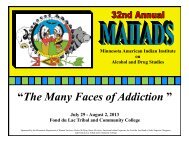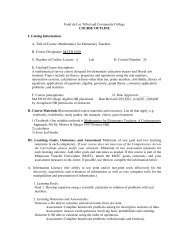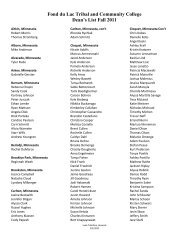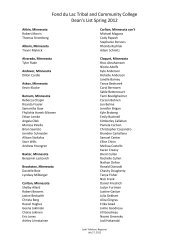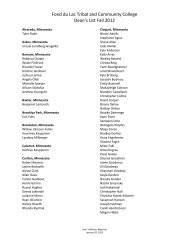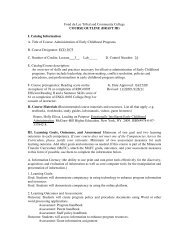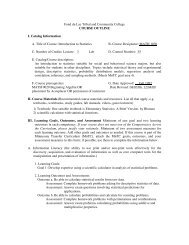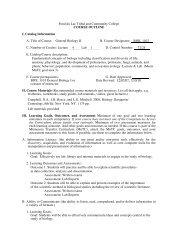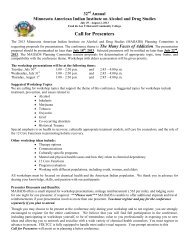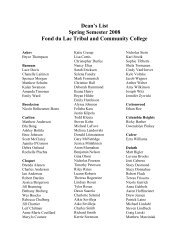ECON 2010 Principles of Economics-Microeconomics
ECON 2010 Principles of Economics-Microeconomics
ECON 2010 Principles of Economics-Microeconomics
You also want an ePaper? Increase the reach of your titles
YUMPU automatically turns print PDFs into web optimized ePapers that Google loves.
Fond du Lac Tribal and Community CollegeCOURSE OUTLINEI. Catalog InformationA. Title <strong>of</strong> Course: B. Course Designator: <strong>ECON</strong> <strong>2010</strong><strong>Principles</strong> <strong>of</strong> <strong>Economics</strong>-<strong>Microeconomics</strong>C. Number <strong>of</strong> Credits: Lecture 3 Lab D. Control Number: 40E. Catalog/Course description:A study concerning the individual units <strong>of</strong> our economic system, including supply anddemand, production and cost, output and input analysis, and other application <strong>of</strong>microeconomics. (Meets MnTC goal area 5).F. Course prerequisites: None G. Date Approved: 11/29/02Date Revised: 12/17/09II. Course Materials (Recommended course materials and resources. List all that apply, e.g.textbooks, workbooks, study guides, lab manuals, videos, guest lecturers)1. Textbook, Micro Econ, by William McEachern, Southwestern College Publishing, 20092. Study guides are optional for the student and available in the bookstore.3. AV and outside resources are used as applicable.III. Learning Goals, Outcomes, and Assessment Minimum <strong>of</strong> one goal and two learningoutcomes in each competency. If your course does not meet one <strong>of</strong> the Competencies Acrossthe Curriculum, please justify your rationale. Minimum <strong>of</strong> two assessment measures foreach learning outcome. Add other goals and outcomes as needed. If this course is part <strong>of</strong> theMinnesota Transfer Curriculum (MnTC), attach the MnTC goals, outcomes, and yourassessment measures to this form; if possible, use them to complete the information below.A. Information Literacy (the ability to use print and/or non-print tools effectively for thediscovery, acquisition, and evaluation <strong>of</strong> information as well as core computer tools for themanipulation and presentation <strong>of</strong> information.)1. Learning Goals:Goal: The students will acquire the tools for the proper use <strong>of</strong> the internet and other mediafor microeconomic sources.2. Learning Outcomes and Assessments:Outcome: Students will demonstrate the ability to use microeconomic print and non-printsources.Assessment: Class assignmentsAssessment: Group discussionsOutcome: Students will demonstrate the ability to recognize reputable print and non-printmicroeconomic sources.Assessment: Class assignmentsAssessment: Group discussionsB. Ability to Communicate (the ability to listen, read, comprehend, and/or deliver information ina variety <strong>of</strong> formats.)1. Learning Goals:Goal: Students will acquire the tools necessary for effective communication <strong>of</strong> ideas andconcepts central to the study <strong>of</strong> microeconomics.2. Learning Outcomes and Assessments:Outcome: Students will be able to describe and apply microeconomic terminology.
Assessment: Group projectsAssessment: Class assignmentsAssessment: ExamsOutcome: Students will be able to communicate microeconomic information based on casestudies.Assessment: Class assignmentsAssessment: Group discussionsC. Problem Solving (the ability to conceptualize, apply, analyze, synthesize, and/or evaluateinformation to formulate and solve problems.)1. Learning Goals:Goal: Students will acquire the tools to analyze microeconomic principles and concepts.2. Learning Outcomes and Assessments:Outcome: Students will demonstrate the ability to evaluate microeconomic information.Assessment: Class assignmentsAssessment: Group discussionsAssessment: ExamsOutcome: Students will demonstrate the ability to apply microeconomic concepts to today’seconomic situation.Assessment: Class assignmentsAssessment: Group discussionAssessment: ExamsD. Culture (knowledge <strong>of</strong> Anishinaabe traditions and culture, knowledge <strong>of</strong> one’s own traditionsand culture, knowledge <strong>of</strong> others’ traditions and cultures, and/or respect for global diversity.)1. Learning Goals:Goal: Students will be able to recognize that the microeconomic world is a small place thatrequires respect for diversity.2. Learning Outcomes and Assessments:Outcome: Students will demonstrate their knowledge <strong>of</strong> cultural economic diversity.Assessment: Group projectsAssessment: Group discussionOutcome: Students will demonstrate their awareness <strong>of</strong> how microeconomic concepts affectdifferent countries.Assessment: Class assignmentsAssessment: Group discussionDocumentation <strong>of</strong> MnTCGoal 5: History/Social Behavioral Science (Group 2)IV. Course Content (Outline the major topics covered in this course.)1. Art and Science <strong>of</strong> Economic Analysis2. Tools <strong>of</strong> Economic Analysis3. Market System4. Elasticity <strong>of</strong> Supply and Demand5. Consumer Choice and Demand6. Production and Cost in a Firm7. Perfect Competition8. Monopoly9. Monopolistic Competition and Oligopoly10. Resource Markets(revised October 2009)





